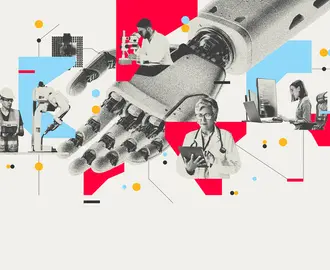Credit: koya79 / iStock
Incorporating generative AI into your company’s technology strategy
Companies already focused on adopting and effectively using digital tools and technologies are now figuring out how generative artificial intelligence fits in.
At Sysco, a food service company with $76 billion in sales in fiscal year 2023, generative AI is another tool that can help with optimizing sales, operations, supply chain performance, merchandising, and product assortment.
Tom Peck, an executive vice president and chief information and digital officer at Sysco, discussed how the company is using generative AI during a recent webinar with MIT Sloan principal research scientist
“Digital technology, AI, and generative AI are not just pervasive in our business, they are really driving our transformation,” Peck said. “Upwards of 80% of orders are now customer-placed, and data from AI is driving those upsell, cross-sell shopping experiences as opposed to more transactional reorders.”
“Where there’s information, where there are processes connecting with customers and operations, there’s an opportunity to apply some AI,” Westerman said.
The two discussed Sysco’s key use cases for generative AI, best practices for implementation, and how generative AI fits into the company’s broader digital strategy.
AI use cases: customer support and smart warehouses
While Sysco has been using traditional AI and machine learning for some time, the company is still experimenting with generative AI use cases.
Currently, its efforts are supporting two primary areas:
Sales and support: Sysco maintains nearly 2 million SKUs, about 200,000 of which are in high demand among customers. The firm has been leveraging traditional AI and analytics to make product recommendations, but generative AI can incorporate unstructured data, such as images or social media data, to capture additional signals. “This will help us be even more creative feeding the shopping cart for our customers,” Peck said. “We are starting to see bigger shopping carts and higher margins by turning traditional AI into more generative AI.”
Sysco also aims to enable a smarter, more proactive call center. This includes leveraging generative AI to perform sentiment analysis, which involves analyzing data about customer state of mind to help build more effective scripts for representatives to use during support calls.
On the sales side, the company is also using generative AI for call planning, by having it suggest and automate next-best actions for team members. Generative AI can also aid in menu curation, helping to develop and circulate carefully chosen images that inspire customers to buy additional products, as well as in customer segmentation, to help sales professionals better target offerings. “It’s a great way to make our teams more effective and get the right product to delight the customer,” Peck said.

Leading the AI-Driven Organization
In person at MIT Sloan
Register Now
Supply chain: Any warehouse operation, especially in the food industry, is dependent on data and algorithms to move and track product efficiently. In that vein, Sysco is using AI and generative AI to manage inventory, optimize warehouse logistics, and route customer deliveries more efficiently. One example is intelligent substitutions, which means using AI to suggest alternative products when something is out of stock or delivery is impacted by a weather event. Smart routing uses onboard telematics to better manage the company’s 14,000-truck fleet by using information about weather conditions, traffic, and onboard temperature zones in vehicles for more dynamic routing. Generative AI can also guide optimal product picking in the warehouse, and truck loading.
“What’s new here is the data outside of a traditional structured database that can feed a more predictive and more prescriptive route so we’re getting more pieces picked per pallet or more trucks loaded faster,” Peck said. “Ultimately, it’s about running a smarter warehouse.”
Best practices for deployment
Peck made the following recommendations for companies looking to evolve their use of generative AI.
Integrate generative AI into broader technology strategy. At Sysco, AI and generative AI are components of a broader automation strategy, Peck said. Most business cases can be solved with robotic process automation, bots, or traditional AI. If those technologies can’t solve the problem, it’s time to consider building something using generative AI capabilities, he said. “I don’t need a generative AI strategy,” Peck said. “I need an automation strategy.”
Related Articles
Consider buying versus building. Sysco opts to purchase AI capabilities such as robotic process automation bots and tools before building its own large language models because Peck prefers the capabilities to be part of a native tool set. “We’ll buy and leverage what we already have, and then, if we have to, we will go to one of the technology providers,” he said.
Understand roles and talent. Sysco views generative AI as a productivity enhancer for humans rather than as an employee replacement. Instead of creating a formal AI team, Sysco trains and teaches employees new skills and makes sure people have the right tools at their disposal, Peck said. “Don’t underestimate the talent you already have,” he said. “I would rather take an internal employee who’s engaged and talented and teach them the skills to become an AI architect or developer.”
CIOs can take a leadership role. Most CIOs or chief information and digital officers are business savvy and play a leading role in driving transformation and business process improvement, Peck said. Generative AI is another opportunity for them to step up and play an influential role.
3 things to remember about using generative AI
- It’s not about the technology. “We’re here to solve business problems first,” Peck said. “Generative AI may or may not be first on the priorities list, and sometimes a more basic automation strategy might solve the problems. But have your business owners work very closely with you.”
- Experiment, and match tools to use cases. Businesses shouldn’t feel overly obligated to build their own vertical technology stack or perfect their data sets before experimenting with AI, Peck said. Instead, companies should experiment with generative AI and put guardrails in place that encourage experimentation. “We’re learning and adapting — that’s how you get smart and comfortable,” he said. “Experimenting allows you to learn and fail fast.”
- Don’t forget organizational implications. Some people fear using AI, and others need help managing expectations about its capabilities. Companies have to understand where people experiment, how they experiment, and what this technology means to people with different roles. “How do you encourage people to learn and participate?” Peck said. “You can’t underestimate the organization and talent component of leading an AI and generative AI strategy.”
Watch the webinar: Preparing your organization for a generative future




